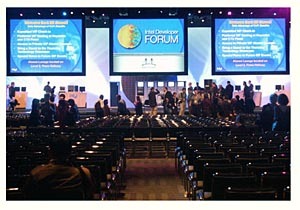Intel to unveil Pentium 4 successor at IDF
Santa Clara (CA) - Intel confirmed that it will showcase its "next generation" desktop processor architecture at the upcoming Intel Developer Forum (IDF) Fall. Code-named Conroe, the new processors promise a significant lower power consumption than the current NetBurst architecture that is used in the Pentium 4 and Pentium D 800.
Intel has no intent of slowing down its aggressive pace to renovate its processor across all segments and quickly move to dual-core products. Rob Chapman, general manager for the IDF, told journalists in a preview of the conference that the company will continue to unveil new code-names of future platforms and offer details about upcoming chips.
Such details and "news" are expected especially to cover the next Centrino platform, code-named "Napa" and the next single- and dual-core Pentium M processor, code-named "Yonah." While most features and specifications of Yonah, which will be released in January of 2006, are public information or were described by Tom's Hardware Guide in earlier articles, there will be substantial interest in Intel's "next generation" processor architecture. The current architecture named "NetBurst" was launched with the Pentium 4 ("Willamette") in 2000 and is quickly nearing the end of its life. With power consumption at record levels, Intel has no room to increase clock speeds and performance levels in the current Pentium 4 500/600 and the 90 nm Pentium D 800. The 65 nm part Pentium D 900 ("Presler"), the last NetBurst Pentium, will launch in Q1 2006 with slight increases in clock speeds.

Further topics of IDF will include wireless broadband technologies such as WiMax, 64-bit updates - which are likely to include the 64-bit Yonah processor "Merom" - as well as the platform technologies VT (virtualization), device management (AMT) and security. The feature "security" is expected to be discussed in the framework of a technology that is based on standards set by the Trusted Computing Group and carries the code-name "LaGrande." We have been waiting for details on LaGrande for several years and according to Chapman, we will have to continue to wait and should not hope for much information on this technology this time around. This is somewhat surprising, especially if one considers the Apple-Intel deal - in which LaGrande appears to play a key part as technology that prevents MacOS to run on any PC.
The first Intel-based Apple PC is not even one year away from its introduction and we would have expected Intel to shed some light on the functionality of the "security" technology it plans to use. Instead, Chapman said that Intel will not talk about processor and platform architectures for Apple PCs at this year's Fall IDF. At this time, another six months of delay really are insignificant and we patiently wait for the Spring 2006 IDF for details on LaGrande and how it will work under MacOS and Windows Vista.
Similarly, Intel will avoid talking extensively about future single-core processors - including the future of the Pentium 4 and Celeron, both of which will receive a 65 nm upgrade, code-named "Cedar Mill," in Q1 of 2006.
IDF Fall will take place in San Francisco's Moscone Center from August 23 to 25. As in every year, AMD will be present to take advantage of the attending journalist crowd to provide product updates as well. According to company representatives, AMD plans to talk about its dual-core products and strategy, showcase virtualization and power saving technologies as well as AMD64 architecture for embedded devices.
Stay On the Cutting Edge: Get the Tom's Hardware Newsletter
Get Tom's Hardware's best news and in-depth reviews, straight to your inbox.
Related stories:
Intel to trim power consumption of desktop CPUs in half by H2 2006
More clock speed for Pentium D with arrival of 900-series